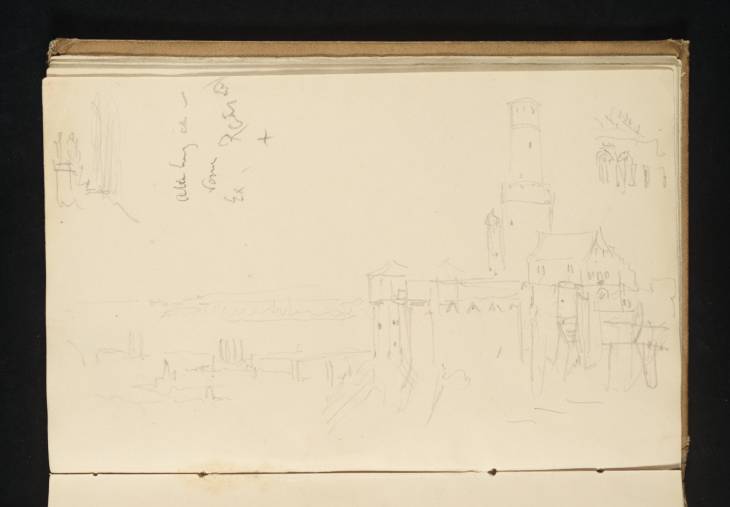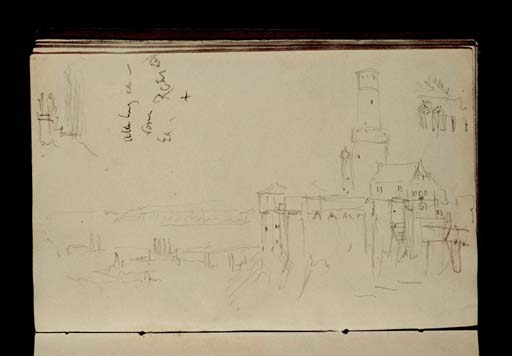Joseph Mallord William Turner The Altenburg, with the Bamberg Below; a Nearby Crucifixion Sculpture; a Detail of Gothic Tracery 1840
Image 1 of 2
Joseph Mallord William Turner,
The Altenburg, with the Bamberg Below; a Nearby Crucifixion Sculpture; a Detail of Gothic Tracery
1840
Joseph Mallord William Turner 1775–1851
Folio 19 Verso:
The Altenburg, with the Bamberg Below; a Nearby Crucifixion Sculpture; a Detail of Gothic Tracery 1840
D31312
Turner Bequest CCCX 19
Turner Bequest CCCX 19
Pencil on cream wove paper, 126 x 198 mm
Inscribed by Turner in pencil ‘Altenburg ca – | [...] | Ex | R[...] | X’ towards top left, ascending vertically
Inscribed by Turner in pencil ‘Altenburg ca – | [...] | Ex | R[...] | X’ towards top left, ascending vertically
Accepted by the nation as part of the Turner Bequest 1856
References
1909
A.J. Finberg, A Complete Inventory of the Drawings of the Turner Bequest, London 1909, vol.II, p.997, CCCX 19, as ‘Castle, with tower beside river. – “Altenberg ca – vom. Ex. – R ... (?).” (There is an Altenberg near Bamberg.)’.
1995
Cecilia Powell, Turner in Germany, exhibition catalogue, Tate Gallery, London 1995, pp.71, 82 note 58, p.242, as ‘Bamberg: The Altenburg with the city below, with details | Page also inscr. Altenburg ca[...]; Ex; R[...]; X’.
The drawing was made with the page turned horizontally. Going by Turner’s partly illegible inscription, Finberg noted: ‘There is an Altenberg near Bamberg.’1 Cecilia Powell has confirmed the subject:2 the medieval Altenburg castle in the right foreground, high on its hill overlooking Bamberg to the north-east. The complex is viewed from a little to the north-west, from where its bastions are seen across a gully crossed by a bridge to the pitched-roofed gatehouse on the right. The immediate view down to the town in the Regnitz Valley is now largely obscured by woods around the castle.
At the top left is a small detail which appears to indicate the freestanding Baroque Crucifixion sculpture which still stands on a plinth to the left of Turner’s viewpoint. Above the castle is a detail of Gothic tracery and a stepped gale, likely from the block to the right beyond the gatehouse.
Turner only visited Bamberg on his 1840 tour, and then apparently only for one night, his drawings being limited to the present sketchbook. Its centre is notable for its cathedral, several large churches and other picturesque buildings, which Turner drew attentively both from within the town and from the heights of the Altenberg; see also folios 26 verso–28 verso, 45 recto, 46 recto, 47 verso, 48 recto, 65 recto–66 recto and 67 recto (D31327–D31331, D31364, D31366, D31369–D31370, D31404–D31406, D31408).3
A pencil and chalk drawing on grey paper, showing a substantial town or city (Tate D34060; Turner Bequest CCCXLI 340), is listed in Finberg’s 1909 Inventory as ‘Quay and bridge. – “Bamberg” (?)’,4 and dated along with hundreds of such sheets to c.1830–41. However, Turner scholar Dr Bernard Richards has identified the setting as Lyon(s) in eastern France, and has convincingly suggested that the artist’s inscription actually reads ‘Blanching’ or ‘Bleaching’,5 relating to what may be cloth spread out in the foreground.
Technical notes:
The page appears undisturbed, and the drawing is on the verso of the leaf, despite the lack of the customary ‘a’ suffix to indicate this in Finberg’s numbering.1 The otherwise blank recto is inscribed ‘19’ by John Ruskin in red ink in sequence with adjacent pages, and stamped in black ‘CCCX – 19’ at the bottom right.
Matthew Imms
September 2018
How to cite
Matthew Imms, ‘The Altenburg, with the Bamberg Below; a Nearby Crucifixion Sculpture; a Detail of Gothic Tracery 1840 by Joseph Mallord William Turner’, catalogue entry, September 2018, in David Blayney Brown (ed.), J.M.W. Turner: Sketchbooks, Drawings and Watercolours, Tate Research Publication, December 2019, https://www


